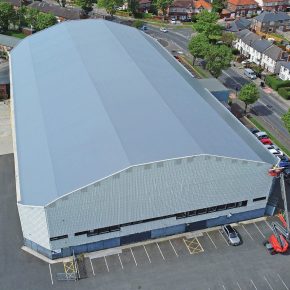
Groundwater flooding damaging to construction and property industry
Groundwater flooding is generally overlooked by the media who will tend to focus on more visually dramatic forms of flooding. However, groundwater flooding is frequently longer lasting and more destructive to property, producing two-to-four times the damage to buildings and causing significant economic harm. Previous guidance has used a susceptibility approach, suggesting the problem is quite widespread. ESI’s new Groundwater Flood Risk Map provides much more reliable and less conservative predictions of groundwater flooding which will offer considerable benefits to the property market. These benefits are likely to include reduced insurance premiums and increased property values.
Groundwater flooding is frequently longer lasting and more destructive to property, producing two-to-four times the damage to buildings and causing significant economic harm
Groundwater flooding occurs when sub-surface water emerges from the ground at the surface, or into man-made ground and sub-surface structures. This could be as a result of persistent rainfall recharging aquifers beyond capacity, high river levels, or tides driving water through near-surface deposits. Compared to surface water flooding, groundwater flooding can last considerably longer, with incidents lasting anything from a week to several months. This longevity tends to make groundwater flooding highly damaging to properties.
Although emergent groundwater tends to be clear and relatively clean compared to muddy fluvial flood waters, it has the potential to be contaminated by sewers and brownfield sites. Groundwater flooding can also be the catalyst for many surface water floods, as it prevents rainfall infiltration.
The Law Society has recently published a practice note which highlights the need to consider all sources of flooding. Solicitors overseeing property transactions are obliged to make their clients aware of any potential flood risks prior to completion.
Groundwater flooding occurs when sub-surface water emerges from the ground at the surface, or into man-made ground and sub-surface structures
It is therefore essential that developers are aware of any possible flood risks so that they understand their transactional implications. Before last October’s publication of ESI’s Groundwater Flood Risk map, the property sector had often used more conservative approaches such as the British Geological Survey’s (BGS) 2007 national Susceptibility to Groundwater Flooding dataset, even though the BGS clearly states this resource was intended for broader regional or national planning purposes and was not to be used in isolation to make individual planning decisions.
The ESI Groundwater Flood Risk Map has for the first time provided a consistent approach for England and Wales, and this shows that there are considerably less properties at risk from groundwater flooding than previously assumed. The data behind the flood risk map uses groundwater levels, and hydrogeological and geological data and algorithms which give an assessment of the risk of flooding at any specific location. Occurrence of historical groundwater flooding events has been used to calibrate and verify risk classifications, and the algorithms were developed iteratively to achieve consistency with available records.
ESI’s Groundwater Flood Risk Map provides a powerful tool at planning stage where assessments of groundwater level, flow and quality typically rely on data collected over a relatively short time. The interpretation of these types of data often leads to an underestimate of flow and level which can have a real impact on the validity and quality of drainage and contaminant migration assessments. Changes in groundwater levels and gradients are typical responses to recharge and can increasingly lead to an expression of flooding at the surface, impacting vulnerable land uses and built assets.
This article originally appeared in the ABC+D magazine. Click here if you would like to find out more
ESI is confident that the new map will see a sea-change in the consideration and assessment of groundwater flooding. The move to a risk-based model is excellent news for thousands of homeowners and landowners who have previously seen their property flagged as susceptible, where the map now shows there is no significant risk of flooding. ESI is working in consultation with dozens of leading Local Flood Authorities to continue to develop and evolve the map, and its team is on hand to answer any questions from developers, architects, contractors, and other professionals allied to the sector. Government departments and water companies have also demonstrated their interest and confidence in the map through recent licence purchases.
Latest news

23rd April 2024
Geberit brings Parallel World to Clerkenwell Design Week
Visitors to this year’s Clerkenwell Design Week (21 – 23 May) can step into a parallel world and discover the benefits of cleaning with water, thanks to Geberit.
Posted in Articles, Bathrooms & Toilets, Bathrooms, Bedrooms & Washrooms, Building Industry Events, Building Industry News, Building Products & Structures, Building Services, Exhibitions and Conferences, Innovations & New Products, Interior Design & Construction, Interiors, Plumbing, Restoration & Refurbishment, Retrofit & Renovation
23rd April 2024
Mitsubishi Electric Ecodan Heat Pumps and Water Cylinders to be stocked by The Boiler Shop
Mitsubishi Electric’s full range of Ecodan heat pumps and hot water cylinders are to be stocked by one of the north-west’s best established independent merchants, The Boiler Shop.
Posted in Articles, Building Industry News, Building Products & Structures, Building Services, Facility Management & Building Services, Heating Systems, Controls and Management, Heating, Ventilation and Air Conditioning - HVAC, Plumbing, Posts, Retrofit & Renovation, Sustainability & Energy Efficiency
23rd April 2024
Trio of Senior products used in new Nottingham residential scheme
Solutions from Senior Architectural Systems have helped complete The Barnum – a new residential development on Nottingham’s Queen’s Road.
Posted in Aluminium Products, Articles, Building Industry News, Building Products & Structures, Building Systems, Case Studies, Curtain Walling, Doors, Glass, Glazing, Posts, Restoration & Refurbishment, Retrofit & Renovation, Walls, Windows
22nd April 2024
New EJOT role will develop strategic support for UK flat roofing sector
EJOT UK has taken a major step in the expansion of its support for the flat roofing market by appointing one of its most experienced building envelope fastening specialists as its first sector-dedicated business development manager.
Posted in Articles, Building Industry News, Building Products & Structures, Building Systems, Innovations & New Products, Posts, Recruitment, Restoration & Refurbishment, Retrofit & Renovation, Roofs
 Sign up:
Sign up: